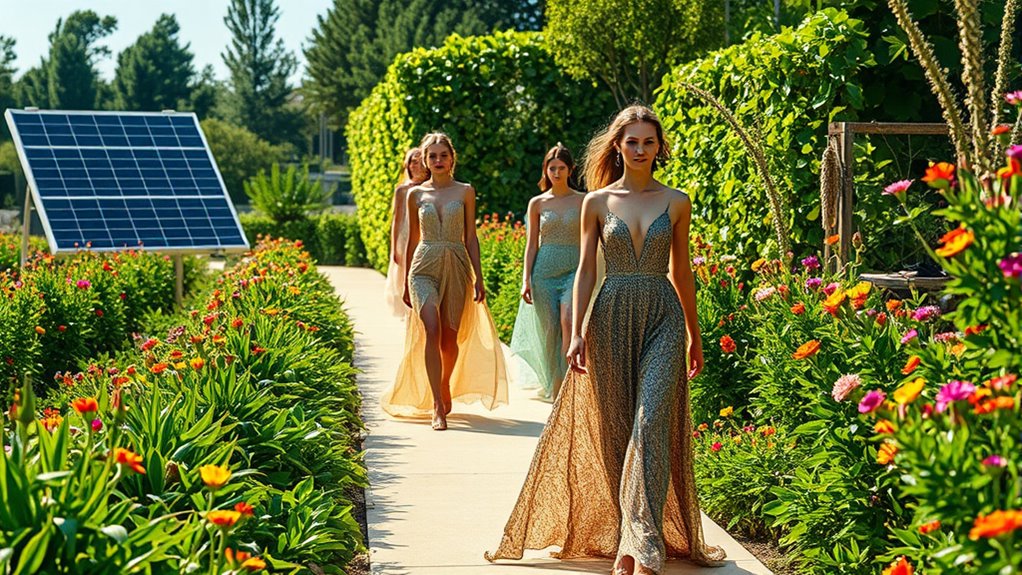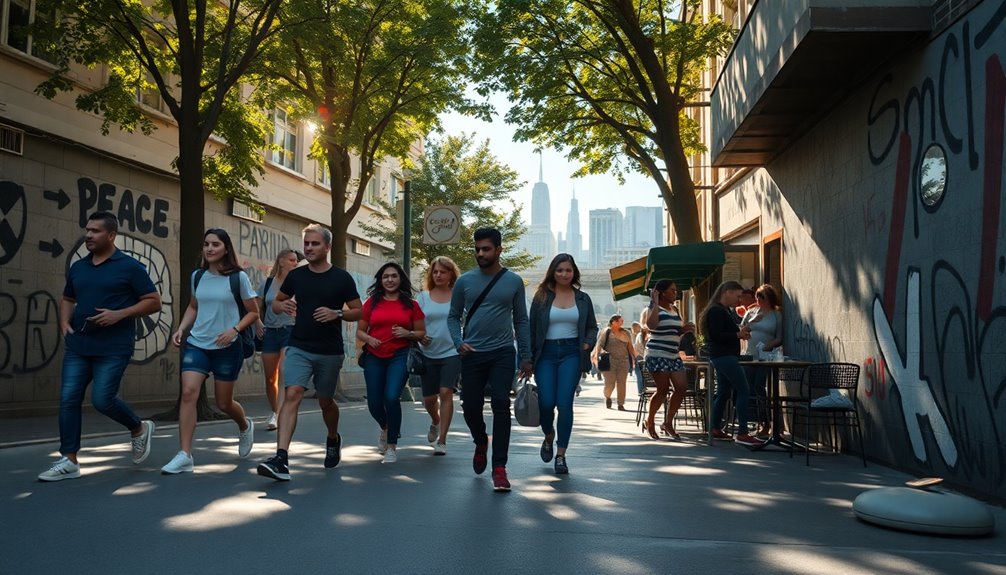Luxury fashion is tackling climate change by adopting sustainable materials like recycled fibers, bio-based fabrics, and plant-based leathers, while phasing out animal products. Brands improve energy efficiency with renewable power, upgrade facilities, and optimize logistics to cut emissions. They promote circular markets and secondhand sales to extend product life. Industry collaborations and stricter regulations push brands toward greater transparency and responsible sourcing. Keep exploring how these efforts are shaping a greener luxury future.
Key Takeaways
- Luxury brands are adopting sustainable materials like recycled nylon, bio-based fibers, and plant-based leathers to reduce environmental impact.
- They are transitioning away from animal products, promoting synthetic and plant-based alternatives to lower carbon footprints.
- Facilities are upgrading to energy-efficient systems and utilizing renewable power sources such as solar and wind.
- Industry collaborations and compliance with regulations enhance transparency and promote sustainable supply chain practices.
- Circular practices, including secondhand markets and product recycling, extend product lifecycles and reduce waste.
Embracing Sustainable Materials and Innovation
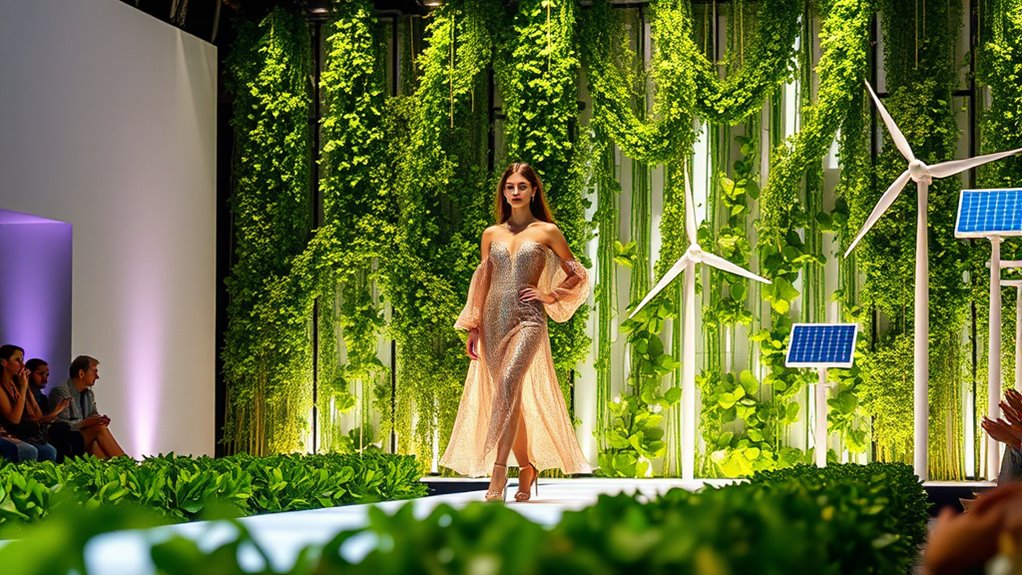
Luxury fashion brands are actively adopting sustainable materials and innovative technologies to lessen their environmental impact. You’ll find brands shifting to sustainable materials like recycled nylon, plant-based fibers, and bio-engineered fabrics, which substantially reduce waste and resource use. They’re also embracing innovation by developing eco-conscious sourcing methods and exploring new materials like mushroom mycelium and bio-based polyurethane as alternatives to animal leather. Companies like Prada and Stella McCartney lead the way with product innovation, using recycled and biodegradable materials to meet consumer demand for sustainability. The market for these sustainable luxury materials is booming, with brands investing heavily in eco-friendly manufacturing processes. Initiatives like LVMH’s Nona Source platform make sustainable fabrics more accessible, encouraging designers to create circular, waste-reducing collections that align with environmental goals. Furthermore, integrating principles from creative practice can inspire innovative approaches to sustainable design, fostering fresh ideas and solutions in the industry. Additionally, fostering dynamic communication exercises within design teams can enhance collaboration and innovative thinking around sustainable solutions. Incorporating life cycle assessment tools into the design process can help brands better understand and minimize the environmental impact of their collections.
Transitioning Away From Animal-Based Products
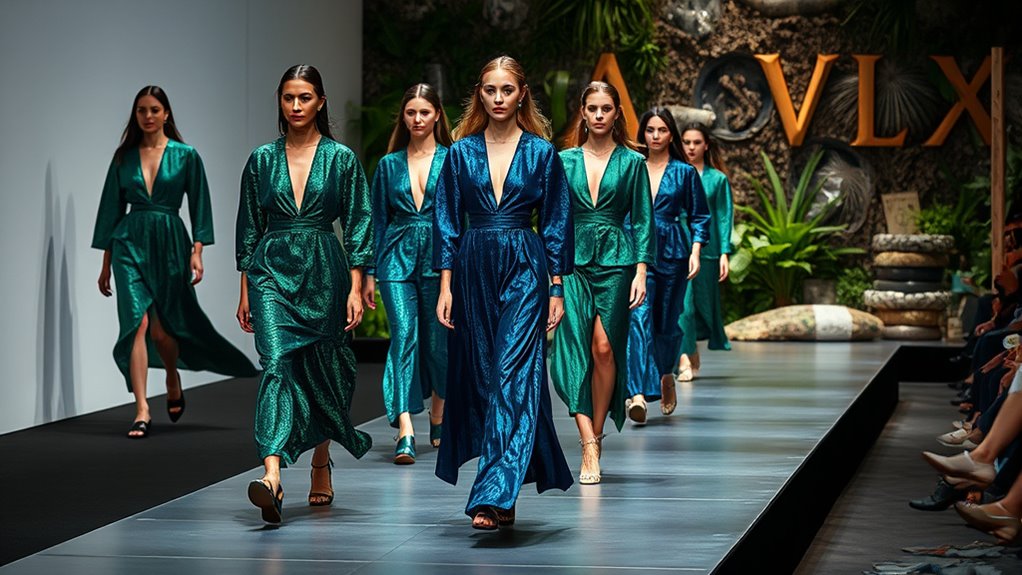
As consumer awareness and environmental concerns grow, many brands are actively shifting away from animal-based products. They’re embracing vegan materials and sustainable alternatives to reduce their ecological impact. Luxury brands like Gucci and Prada now develop bio-based and plant-derived options, such as Demetra made from bio-polyurethane, viscose, and wood. Major companies like Stella McCartney champion synthetic and plant-based leathers to eliminate reliance on animal products altogether. The fur industry is also transforming, with eco-fur and other sustainable options replacing traditional animal-derived fur. Over half of luxury shoppers now prefer fur-free collections, prompting brands like Armani and Dolce & Gabbana to phase out animal-derived materials. This shift is driven by consumer demand, environmental concerns, and advancements in bio-fabrication technologies.
Implementing Energy Efficiency and Renewable Power
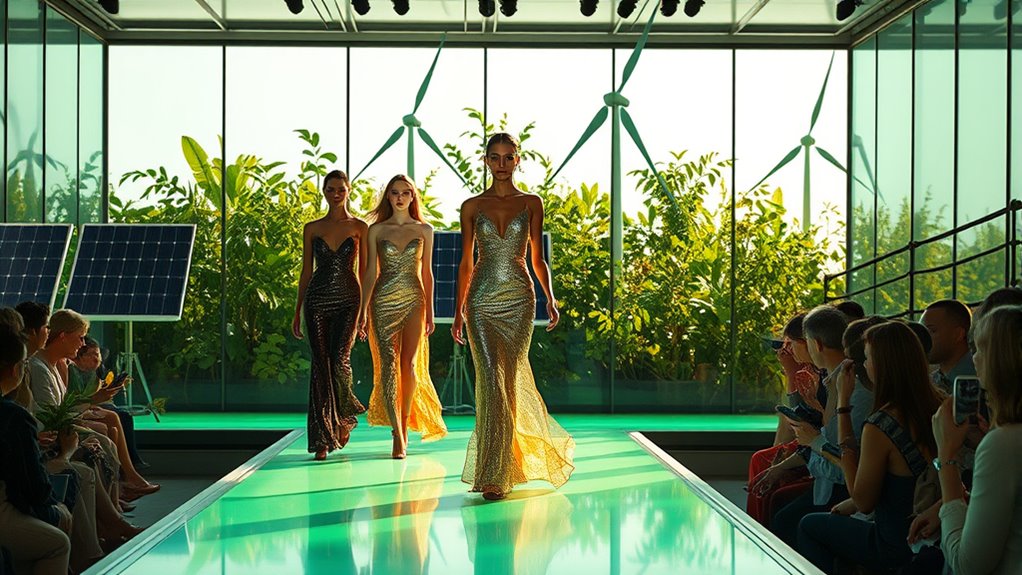
You can reduce your brand’s environmental impact by upgrading facility operations, like lighting and HVAC systems, to be more energy-efficient. Investing in renewable energy sources such as solar and wind helps power your manufacturing and retail spaces sustainably. By actively cutting power consumption and switching to renewables, you move closer to your climate goals while maintaining profitability. Incorporating sound healing science into wellness initiatives can also support employee well-being and sustainability awareness. Employing sound design techniques can create calming auditory environments that enhance employee focus and reduce stress. Engaging in energy management strategies ensures that your efforts are optimized for maximum environmental benefit and cost savings.
Upgrading Facility Operations
Upgrading facility operations through energy efficiency and renewable power is a crucial step toward sustainable luxury fashion. By adopting energy-efficient lighting, HVAC systems, and machinery, you can cut operational energy use by up to 30%. Shifting to renewable energy sources, like solar or wind, helps your brand reach near-zero carbon emissions. Improving insulation and automating systems reduce energy waste and optimize facility operations. On-site renewable generation, such as rooftop solar panels, supplies a significant portion of your electricity, decreasing reliance on fossil fuels. You can track and enhance energy use with smart monitoring systems, supporting continuous sustainability improvements. Utilizing mixing techniques in system integration can further optimize energy management and efficiency. Additionally, leveraging energy management systems can provide real-time data to identify inefficiencies and implement targeted improvements. Incorporating energy-efficient practices, such as regular maintenance and staff training, further enhances overall sustainability efforts. Incorporating renewable power sources also demonstrates your brand’s commitment to environmental responsibility and can improve stakeholder perception.
Investing in Renewable Energy
Investing in renewable energy builds on efforts to improve facility operations by harnessing cleaner power sources. Many luxury brands, like Gucci, aim to power 100% of their facilities with renewable energy by 2025, cutting their carbon footprint. Installing on-site solar panels at manufacturing sites and retail stores helps generate clean electricity and reduce reliance on fossil fuels. Upgrading to energy-efficient lighting and optimizing manufacturing processes also support emission reduction and lower operational costs. Additionally, the supply chain plays an essential role; raw material producers in countries like Vietnam and Bangladesh are increasingly shifting to wind and solar power. Industry initiatives, backed by partnerships and policies, encourage this shift, with decarbonizing energy use potentially reducing emissions in the luxury fashion sector by up to 40%. Emphasizing vibrational alignment with sustainability goals can further enhance the effectiveness of these efforts. Moreover, integrating renewable energy solutions into existing infrastructure can accelerate progress towards a more sustainable fashion industry. Incorporating sustainable energy practices across the entire supply chain ensures a more comprehensive approach to reducing environmental impact, especially as the textile industry continues to innovate with eco-friendly materials and methods.
Reducing Power Consumption
To effectively reduce power consumption, luxury fashion brands are adopting energy-efficient technologies and practices across their operations. They focus on increasing energy efficiency by installing LED lighting, advanced HVAC systems, and smart energy management systems, which lower electricity use and operating costs. Many brands are investing in renewable energy sources like solar and wind power to supply their manufacturing facilities and retail stores, aiming for net-zero energy consumption. Some have committed to powering their entire supply chains with renewable energy by 2030, further supporting sustainability goals. These efforts help minimize their carbon footprint and boost climate responsibility. Studies show that energy efficiency measures can cut greenhouse gas emissions by up to 30%, making them essential in the fight against climate change in the luxury fashion industry. Incorporating renewable power into their energy mix also encourages innovation and demonstrates leadership in environmental responsibility. Additionally, the adoption of advanced energy storage solutions can help brands manage energy supply fluctuations and maximize the use of renewable sources. Embracing energy management systems allows brands to optimize energy consumption patterns and further reduce waste. Implementing energy audits can identify additional opportunities for efficiency improvements and cost savings.
Rethinking Supply Chains to Reduce Carbon Impact
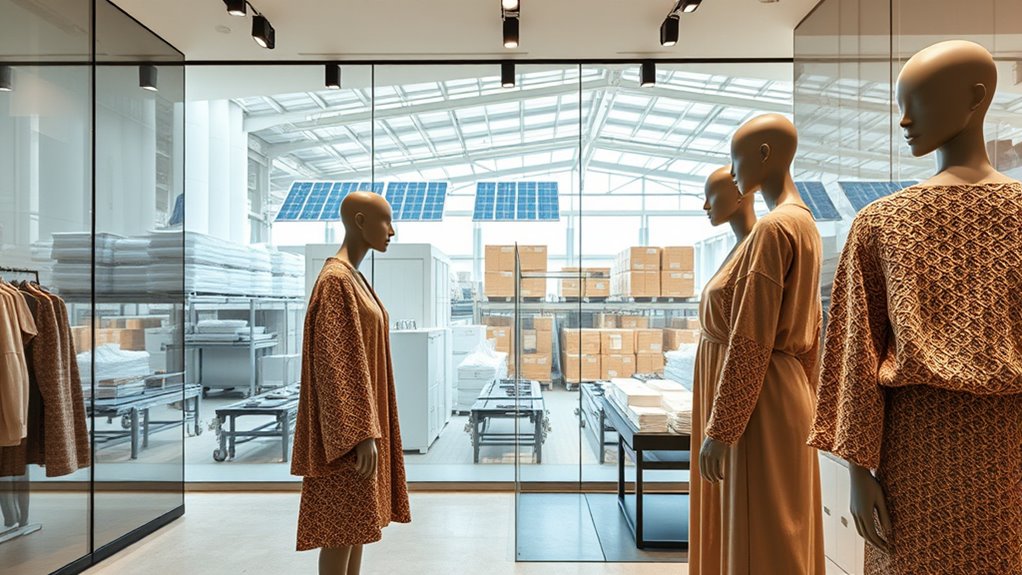
Rethinking supply chains is essential for luxury fashion brands aiming to cut their carbon footprint. You can do this by prioritizing sustainable sourcing, such as shifting to eco-friendly materials like mycelium-based leather and bio-based fibers. Major brands are optimizing logistics through:
- consolidating shipments
- increasing renewable energy use in transportation
- reducing overproduction
These steps help lower carbon emissions across your supply network. Additionally, implementing circular economy practices—like designing for recyclability and extending raw material lifecycles—further minimizes environmental impact. Addressing vulnerabilities in raw material sourcing, especially in climate-sensitive regions, guarantees stability and reduces emissions. Transparency and responsible due diligence are vital for mapping your supply chain, ensuring sustainable practices, and reducing climate-related risks. Supply chain management is a crucial move toward a more sustainable, responsible fashion industry. Incorporating traceability systems can enhance transparency and accountability throughout the supply chain, reinforcing your commitment to sustainability. Developing resilient supply chains also involves understanding and managing climate-related risks, which helps safeguard your brand against environmental disruptions. Additionally, leveraging sustainable logistics can streamline operations and further decrease your overall carbon footprint.
Promoting Circular Fashion and Secondhand Markets
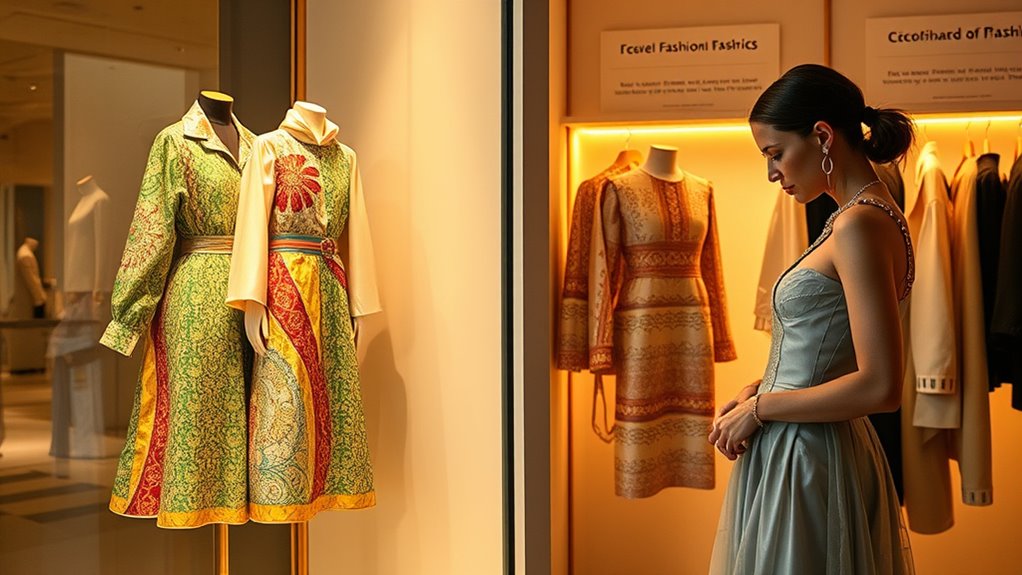
Did you know that the rise of secondhand luxury markets is transforming sustainability in fashion? These markets are a key part of circular fashion, where reuse and recycling extend product lifecycles. Luxury brands like Oscar de la Renta and Gucci are partnering with platforms such as TheRealReal and Vestiaire Collective to verify authenticity and promote pre-owned items. Buying secondhand luxury products supports sustainability, with 56% of luxury shoppers selling their items secondhand and 55% planning to seek pre-owned goods after the pandemic. Thrift and vintage shopping are becoming popular among eco-conscious consumers, offering high-quality, environmentally friendly alternatives to new products. Circular fashion is also gaining momentum as a comprehensive approach to sustainable luxury, encouraging consumers to participate in responsible consumption habits. Additionally, the integration of secondhand markets into mainstream luxury retail strategies highlights a shift toward more sustainable consumption models.
Strengthening Industry Collaboration and Transparency
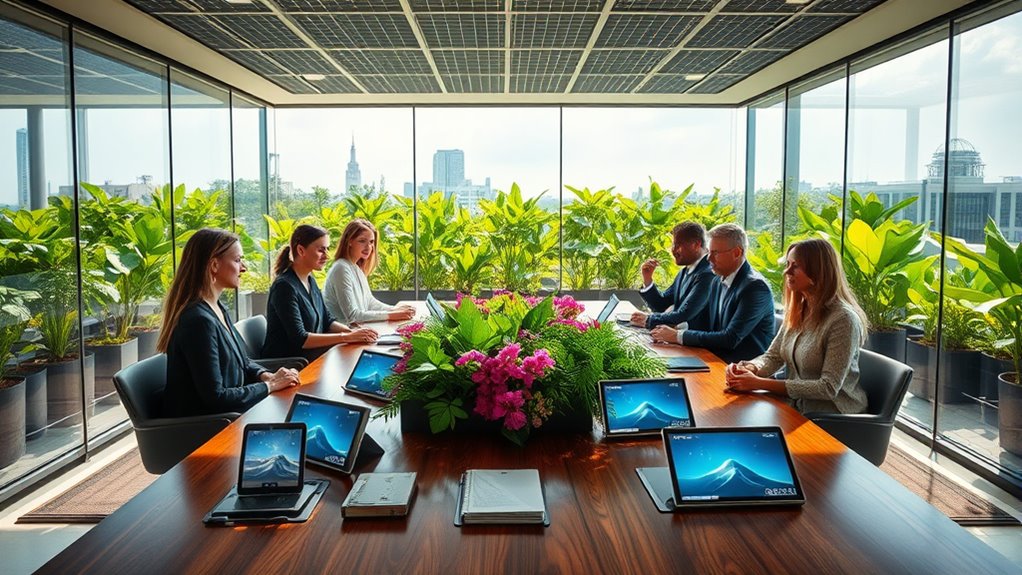
You can see that industry collaboration initiatives like the Responsible Luxury Initiative® are driving brands to share commitments and improve transparency. Regulations such as the EU’s Green Claims Directive push brands to substantiate their environmental claims and be accountable. When brands work together and communicate openly, they build trust with consumers and set stronger sustainability standards across the industry.
Industry-Wide Sustainability Initiatives
Industry-wide sustainability initiatives are gaining momentum as luxury brands recognize the importance of industry collaboration and transparency to tackle climate change. Platforms like the Responsible Luxury Initiative® foster shared commitments and knowledge exchange, strengthening sustainability efforts across the sector. Cross-industry initiatives aim to reduce collective environmental impact by aligning standards, sharing best practices, and pooling resources for sustainable innovation. Transparency measures, such as the EU’s Green Claims Directive and CSRD, require brands to substantiate environmental claims, promoting accountability. You can expect to see a focus on:
- Standardized metrics for comparing sustainability performance
- Data-driven reporting to identify joint improvement areas
- Multistakeholder partnerships to scale efforts
These initiatives help create a unified approach, amplifying the industry’s ability to address climate challenges effectively.
Enhanced Transparency Practices
Enhanced transparency practices are transforming how luxury brands build trust and demonstrate accountability. By openly reporting sustainability metrics, such as carbon footprints and supply chain impacts, brands meet evolving regulatory standards like the EU’s CSRD. Industry collaborations, like the Responsible Luxury Initiative®, enable brands to share best practices, data, and innovations for sustainable sourcing and manufacturing. Increased transparency measures include third-party audits and certifications that verify claims about eco-friendly materials, fair labor practices, and environmental impact reductions. Nearly 60% of luxury consumers now prioritize transparency, prompting brands to disclose detailed information about raw material origins and environmental footprints. These practices help reduce greenwashing, foster consumer trust, and promote a collective industry effort toward verified, consistent sustainability disclosures.
Navigating Regulatory Frameworks and ESG Commitments
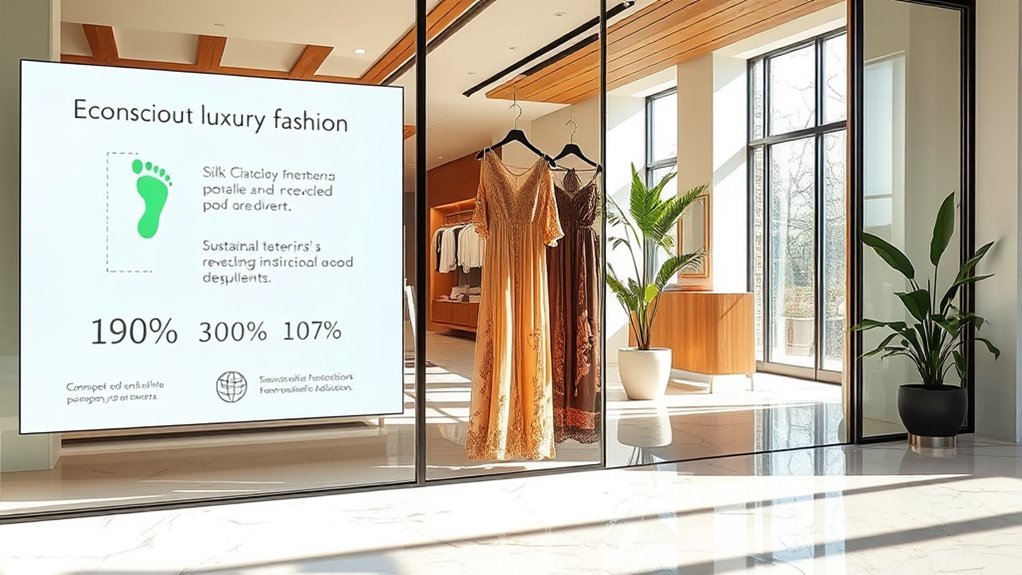
Managing regulatory frameworks and ESG commitments has become a critical challenge for luxury brands aiming to demonstrate genuine sustainability. With regulations like the EU’s Green Claims Directive and CSRD, you’re now required to substantiate environmental claims and improve sustainability reporting. The EU’s Due Diligence Directive (CSDDD) pushes you to oversee environmental and human rights impacts throughout your supply chain, with compliance deadlines tightening. Additionally, standards such as the ESPR set eco-design requirements, including recycled content and packaging restrictions. To avoid legal risks and protect your reputation, you must guarantee your environmental claims are clear and verifiable, especially as greenwashing faces increasing scrutiny. Remember, successful compliance hinges on understanding these regulations and consistently aligning your ESG commitments with evolving legal standards.
- Transparency in claims
- Supply chain accountability
- Verifiable sustainability metrics
Frequently Asked Questions
What Does Fashion Have to Do With Climate Change?
You might wonder what fashion has to do with climate change, but it’s more connected than you think. The industry emits around 4% of global greenhouse gases, contributing considerably to warming. Raw materials like leather and cotton are affected by climate impacts like droughts and floods. By choosing sustainable options and supporting eco-conscious brands, you can help reduce fashion’s environmental footprint and combat climate change.
Are Luxury Brands Good for the Environment?
Thinking about whether luxury brands are good for the environment is like weighing a delicate balance. They’re making strides by adopting eco-friendly materials and promoting secondhand markets, which helps reduce waste. But, their high resource use and emissions still cast doubt. You can see efforts are genuine, yet the industry’s overall impact is complex, so it’s a mix of progress and challenges that you should consider carefully.
Is the Fashion Industry One of the Largest Contributors to Global Warming?
Yes, you should know that the fashion industry is one of the biggest contributors to global warming. It emits about 2.1 billion metric tons of greenhouse gases annually, which is roughly 4% of all global emissions. Textile production pollutes water and releases microplastics. If no action is taken, industry emissions could jump to 2.7 billion tons by 2030, making climate change even worse.
Can Luxury Fashion Be Sustainable?
You might wonder if luxury fashion can be sustainable. The good news is, many brands are actively making changes, like shifting to eco-friendly materials such as bio-based polyurethane, recycled fibers, and plant-based leathers. You’ll see a rise in secondhand markets, which promote longevity and waste reduction. Brands are also committing to net-zero goals, proving that luxury fashion can blend high-end style with genuine environmental responsibility.
Conclusion
Just like a luxury yacht steadily changing course to avoid storms, the fashion industry is steering toward sustainability. With each innovative material and eco-friendly step, you’re part of a movement that’s reimagining beauty without harming the planet. Remember, every small effort counts—when brands collaborate and consumers demand change, the ripple effect can transform the entire landscape. Together, you’re helping fashion sail smoothly into a greener, more responsible future.
